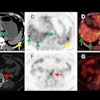PET has revealed that mechanisms other than amyloid brain deposits may underlie depressive symptoms in people later in life, according to a recent study.
The finding is from an analysis of imaging in 12,769 participants enrolled in Alzheimer’s disease trials and provides a clearer picture of the pathogenesis of late-life depression, noted lead author Wietse Wiels, MD, of the Free University of Brussels, and colleagues.
“A better understanding of the association between depressive symptoms and amyloid pathology will strengthen clinical diagnostics and prognosis and is essential for further therapeutic research,” the group wrote. The study was published January 22 in JAMA Psychiatry.
Given a known connection between depression and cognitive decline in older individuals, much research has focused on associations between late-life depressive symptoms and Alzheimer’s disease amyloid pathology, the authors explained. Yet findings to date have been heterogenous and preclude the drawing of general conclusions, they noted.
To further elucidate the issue, the researchers analyzed data from 9,746 individuals with normal cognition and 3,023 participants with mild cognitive impairment between 34 and 100 years old enrolled in the Amyloid Biomarker Study, an ongoing international data pooling initiative.
The group determined the presence or absence of amyloid pathology in the groups based on amyloid PET scans, as well as beta-amyloid 1-42 levels in cerebrospinal fluid. The presence of depressive symptoms was based on depression rating scale scores, evidence of a current clinical diagnosis of depression, or self-reported depressive symptoms.
According to the analysis, among the 9,746 individuals with normal cognition, 937 (9.6%) had depressive symptoms and 2,648 (27.2%) had amyloid pathology, and thus the presence of depressive symptoms was not associated with amyloid pathology (odds ratio [OR], 1.13; p = 0.29).
Among the 3,023 individuals with mild cognitive impairment, 824 (27.3%) had depressive symptoms and 1,668 (55.8%) had amyloid pathology, and thus the presence of depressive symptoms was associated with a lower likelihood of amyloid pathology (OR, 0.73; p = 0.001).
“Individuals with [mild cognitive impairment] exhibiting mild and especially moderate to severe depressive symptoms were generally less likely to exhibit amyloid pathology compared to those without depressive symptoms,” the group wrote.
Ultimately, cognitive decline and depressive symptoms share common risk factors and this raises the possibility of clinical overlap between them, but perhaps without a directly causal relationship, the researchers wrote. This study supports the concept that late-life depression may be primarily mediated by nonamyloid pathologies such as cerebrovascular factors, they noted.
“These findings indicate that mechanisms other than amyloid accumulation may underlie depressive symptoms in older adults without dementia,” the group concluded.
The full study is available here.



















